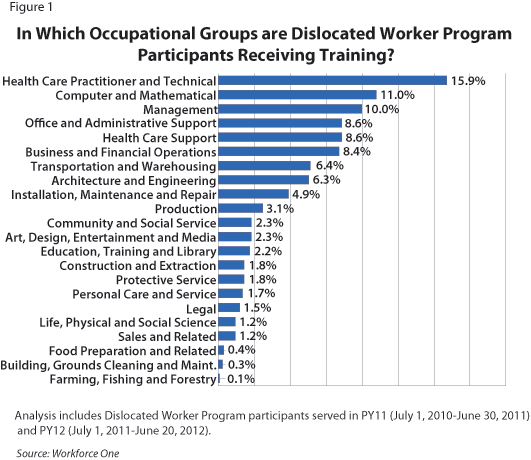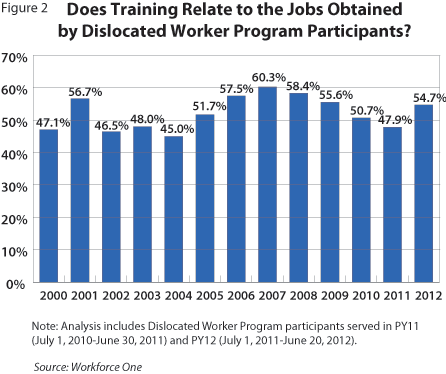by Ellen Bendewald and Rachel Vilsack
September 2013
Data from DEED's Dislocated Worker Program found that more than half of the people who participated in the program over a 13-year period landed jobs related to their training.
How are you going to use that degree? It's a question dreaded by most students, especially if they just completed a philosophy, history or anthropology degree. Many people in those fields often end up working in completely unrelated occupations. Students pursuing specific occupational training, however, generally have a better chance of finding work in their field. Someone obtaining a degree in nursing, for example, is qualified for work in a number of health care-related jobs.
Workforce development programs generally focus on training people in health care and other occupations where the demand for jobs is greatest. This article looks at whether one of those programs, DEED's Dislocated Worker Program, succeeded at linking training with related employment.
The Dislocated Worker Program is designed to help laid off Minnesotans overcome difficult employment barriers in order to find suitable work as quickly as possible.1 Some workers need additional education to stay competitive in their current occupations, while others need to be retrained in new, in-demand fields.
The program's performance is tied to how well participants do in training (Do they earn a credential?) and how well they do in the labor market (Do they find and keep a job? How much do they earn?). An additional indicator of program efficiency — above and beyond official performance measures — is whether Dislocated Worker Program participants find jobs related to the publicly funded training they receive through the program.
Local service providers who administer the Dislocated Worker Program track participants in Workforce One, a management information system database. In Workforce One, employment counselors are asked to provide an occupational code (ONET) that relates to the participant's training, as well as an occupation title and ONET code associated with the participant's ultimate employment. This analysis looked at that data to find out whether participants found jobs in occupations that matched their program training. A data and methodology sidebar with this story provides more details on how the study was conducted.
The bottom line of the findings is this: More than one-half of Dislocated Worker Program participants found employment in the same occupational group for which they were trained.
To receive training in the Dislocated Worker Program, participants must demonstrate to their employment counselors that training will improve their chances of getting a job. Not all program participants want to receive training.2 Of participants pursuing classroom or occupational skills training leading to a credential, one-third sought training in health care or computer occupations between July 1, 2010, and June 30, 2012 (see Figure 1). Alternatively, less than 1 percent of participants entered training in food preparation, building and grounds maintenance, or farming-related activities.

The following list shows the top 10 detailed occupations in which Dislocated Worker Program participants received training between July 1, 2010, and June 30, 2012:
These occupations represent some of the most in-demand jobs in Minnesota, with all appearing on DEED's Occupations in Demand list.
An examination of 13 years of training and jobs data shows that 45 to 60 percent of the jobs obtained after people left the Dislocated Worker Program were directly related to program training (see Figure 2). For instance, 54.7 percent of Dislocated Worker Program participants who received a credential in 2012 found a job that matched their occupational training. So a participant who was trained in a business occupation exited the Dislocated Worker Program to take a job in a business occupation.

Not having an occupational match, however, does not necessarily indicate the training was not important in landing a job. For example, think of someone who trained as a welder but found a job in sales. That job may be at a welding company, and the training may have been the key to landing the job. Although this would not be a match we could easily examine, by slightly loosening our definition of a match between training and employment, our match rate increased by 5 to 8 percent compared with Figure 2. The new definition was expanded to include the following:
Figure 2 looks at customers who left the program for jobs during the calendar year, rather than the standard program year (July to June) that is usually referenced with Dislocated Worker Program statistics. This is deliberate. During 2001 and from 2007 to 2009, a slightly higher rate of participant employment was related to training. What distinguishes those years is a recession. From a labor market standpoint, it makes intuitive sense that participants are more likely to find jobs related to their training during difficult economic times, when job opportunities are scarce. When job opportunities are plentiful, participants are slightly less likely to find jobs related to their training.
Dislocated Worker Program guidelines typically require a person to seek training in an occupation in demand. Indeed, this analysis confirms that the top training occupations chosen by Dislocated Worker Program participants are in demand in Minnesota. These program guidelines are intended to increase the chances that the person will find employment, the ultimate goal of the program.
As this analysis shows, the percentage of training participants finding related employment is countercyclical. As the economy improves, the related employment rate decreases. This is in line with anecdotal reports from Dislocated Worker Program counselors, who say their clients generally wish to resume working as soon as an acceptable job offer is extended, even in an occupation different than the one for which they trained.
Because a job search can follow unpredictable paths, we should not expect to see a direct link between training and employment for 100 percent of participants. Even unrelated training may offer a "signaling" effect, indicating to employers that the job candidate is highly motivated. To the extent that this is true, training in any occupation could directly improve the employment chances for Dislocated Worker Program participants.
|
Data and Methodology Program data analysts investigated the accuracy of the occupational codes in Workforce One, using a database of nearly 60,000 lay job titles mapped to ONET codes developed by the National Crosswalk Service Center. This database was developed under a U.S. Department of Labor contract to improve the accuracy of occupational keyword searches, such as on O*NET Online. The matching mechanism is many-to-many: One ONET code may be associated with many lay titles, and one lay title may be associated with many ONET codes. This analysis considers a record validated if its ONET code matches one of the multiple ONET codes associated with its lay job title. The sample was drawn from Dislocated Worker Program participants served between July 1, 2010, and June 30, 2012, who met the following criteria
In all, 5,205 participants fit those parameters, and all results are true for this population at a 95 percent confidence level. Of those records with job titles included in the lay title database, 64 (± 2) percent result in an ONET match at the eight-digit level. Only 51 percent of records in this sample, however, have a job title found in the lay title database. This is low mainly due to abbreviations and misspellings. Editing job titles for spelling increased the found rate to 80 percent, and the ONET match rate did not change significantly from 64 (± 2) percent. This is lower than most automated ONET coders, which tend to have accuracy rates of 80 percent or higher. A secondary avenue for validating occupational codes is to compare them with the CIP codes associated with the training program. The CIP taxonomy was developed by the U.S. Department of Education in order to gather reliable enrollment statistics within various educational fields. Dislocated Worker Program counselors are asked to enter both a CIP code and an ONET code associated with the training program in which their client is enrolled. While ONET codes are not designed to classify training programs, ONET is more familiar to both counselors and participants. This is because participants' training plans are researched and written around an occupational, rather than educational, goal, often using the Department of Labor's O*NET website. This analysis used the National Crosswalk Service Center's CIP-to-ONET crosswalk to determine whether the CIP code and ONET code for the same training program match each other. Again, the matching mechanism is many-to-many, and the record is considered validated if the ONET code on the record matched one of the multiple ONET codes associated with the CIP code on the record. Only 49 (± 2) percent of records were validated using this methodology, suggesting inaccuracy in the CIP codes as well as ONET codes entered into Workforce One. DEED staff members are currently engaged in a re-write of Workforce One, including redesigns to CIP and ONET fields to improve coding accuracy. |
1During SFY 2012 (July 1, 2011, to June 30, 2012), the Dislocated Worker Program spent $20.3 million to serve 13,568 participants, costing nearly $1,500 per participant. In total 7,076 people exited the program, with 5,847 entering unsubsidized employment – a success rate of 82.6 percent.
2There are many sources of training available to Dislocated Worker Program participants that lead to a credential, including educational diplomas, certificates and degrees; registered apprenticeship certificates; occupational licenses; industry-recognized or professional association certifications; and other certificates of skills completion. For the purposes of this analysis, we looked at only the classroom training and occupational skills training activities that lead to a credential, or a formal recognition of an individual's attainment of measurable technical or occupational skills necessary to obtain employment or advance within an occupation. These technical or occupational skills are generally based on standards developed or endorsed by employers.